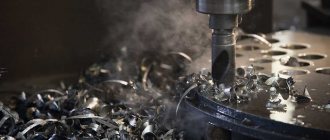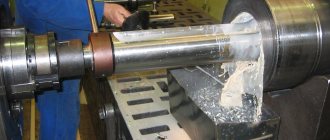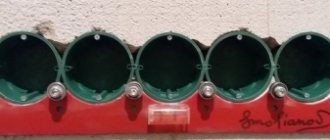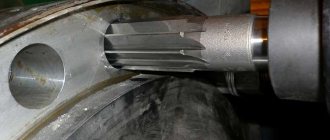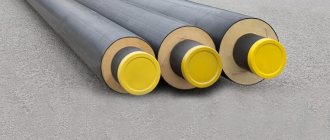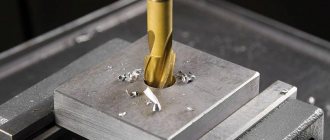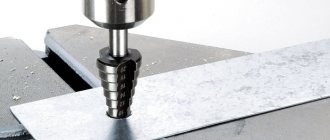Metal punching, or neat execution
So, to create a wide variety of details, from decorative elements and other forms, you often need not only figured cutting or bending, but also metal carving. This is mainly necessary for fastening parts of various structures, and for the most part it is needed solely for decoration.
In accordance with the requirements of appearance and the use of the source material, the extrusion method is determined. For example: for a thin fabric with a density of 0.5–4 millimeters, punching using a special machine will be more effective.
The master takes into account the method of working with the part based on the requirements of the technical design documentation standards.
There are two methods of punching metal: with full and partial diameter. In the first case, the design size of the hole is implied. For the second, it is typical that the size will be smaller than the original and will require further processing.
For the most part, mechanized presses are used for this work with metal; in theory, they are divided into hand tools. These are those that require the regular presence of a person, and those that are fully controlled by an automatic CNC system, a turret punch press.
The essence of technology
Most often, holes are punched in sheet metal 0.5–4 millimeters thick, since due to the design features of the machine used, working with pipes and thicker sheets is practically impossible.
The process itself is carried out using a punch - a punch made of hard alloys, and a matrix - a perforated “substrate” on which the workpiece is placed. Punches can have a variety of shapes, which makes it possible to apply various types of perforation.
The resulting perforated sheets can be used in a wide variety of applications and act as parts of metal furniture, frames of advertising structures, protective covers and grilles.
Conventionally, manual methods of punching metal
Press shears are used as the most accurate and inexpensive method of working with metal. This method is much slower, but optimal for small or private production. Often used in the absence of a mechanized CNC machine.
If we take general concepts, then this method has few differences from the automated one.
Markings are applied to a pre-prepared sheet of metal, but manually. Then the required hole is pressed out with a press.
This approach is the cheapest, but gives a large error in operation, and therefore is not suitable for use in large-scale production.
Large diameter hole
The story about how to cut a hole in a large diameter tile (from 20 mm or more) must begin with the fact that such work is best carried out before laying the tiles on the wall or floor. The algorithm of actions here needs to be performed somewhat differently.
First, it is important to decide what to use to cut a large hole in the ceramic tile. If drilling durable tiles is carried out using a ballerina, then first you need to make a small hole with a drill and a drill bit with a diameter of 4 mm. It will help greatly simplify the next stage of work. Using the ballerina's movable leg, the radius of the future hole is set. The distance between the moving leg and the center should be equal to half the diameter of the hole. After this, the support screw is inserted into the hole made with a drill and securely fixed by twisting.
This must be done with maximum effort. Otherwise, the movable leg will move due to centrifugal force and vibration during operation. The process of drilling tiles begins and is performed at low speeds in a strictly perpendicular position with respect to the material. When drilling tiles, it is necessary to apply even pressure on the tool. There is no need to apply excessive force, otherwise the drill will jam. If the instrument is used correctly, the ballerina will do her job herself.
Note! When working with a ballerina, you need to ensure that the cutting depth is the same throughout the entire circumference. If necessary, the edges can be further trimmed later.
Experts, when talking about how to drill ceramic tiles, do not advise beginners to choose a ballerina for the work described. It is a capricious tool; drilling with it is always accompanied by high vibration, which only an experienced master can pacify. If there is no other tool at hand, it is better for beginners to put a safety case made of plastic on ballerinas for greater safety.
As a first experiment, it is better to use diamond or corundum core drills. They significantly simplify the process and reduce work time. How should you drill ceramic tiles using them? If you look closely at the design of the crowns, you can see a metal round body, inside of which the central guide drill is placed. It must be directed to the center of the marking. And turn on the drill at low speed. Drilling holes in ceramic tiles is done with light pressure. The result should be a round hole with very smooth edges. They then do not need additional modification. Knowing how to drill through tiles using a diamond core bit and a centrifugal drill bit, it’s easy to complete your bathroom renovation yourself.
However, solving the problem becomes noticeably more complicated if a crown without a centrifugal drill is selected. How then can you drill tiles in the bathroom, rather than drilling holes for a faucet or socket, for example? Then, along with the crown, you need to purchase special conductors; they help set the center of the hole. The conductor is attached to the wall using a suction cup so that the device is located exactly on the markings made. In this case, the holes are smooth, drilling occurs where necessary.
There are other tools that can be used when working with crowns without a centrifugal drill. One such thing is manual templates. They look like cut plastic patterns. One template has several holes of different diameters. This is clearly visible in the photo.
To drill tiles in the bathroom, the template is glued to the wall with masking tape. Working with such a device is not very convenient, but it will allow you to maintain accuracy in size. Essentially, a similar template is needed until the crown penetrates the thickness of the tile. Many craftsmen like to work with templates, but they make them themselves from a piece of plywood, the thickness of which is 10 mm. In this case, the drilled tile will also look quite neat.
When there is neither a ballerina nor a diamond crown at hand, a circular drilling method is used. It is carried out using drills of small diameter, the ceramics are pre-processed: construction tape is glued to it and the desired circle is drawn on it with a marker. Exactly according to the sketch, holes of small diameter are drilled in a row, one by one, and the circle cut out in this way is simply extruded. The edges of the tiles cut in this way are uneven and rough; they are finished with files and sandpaper. This method cannot be called quick and easy, but when there is no professional tool at hand, it becomes the only way to cut the required holes. By the way, in this way you can easily cut out a semicircle or make a hole of any other shape.
Automation to help people
Revolving coordinate-punching machines with program control allow you to achieve high productivity and accuracy, eliminating the use of human resources in production. This reduces the risk of injury at work. Thus, before starting operation, a program with precise instructions for the required perforation is entered into the built-in CNC devices. It contains a careful plan for the location of the holes, their exact shapes and sizes.
Each such press is equipped with special punching mechanisms made of a harder alloy, different in diameter and shape - punches. They are automatically replaced by the system depending on the installed program, which speeds up the process. The maximum operating speed of such a machine is 1500 holes per minute.
The turret machine is capable of performing other actions:
– punching – extrusion of various shapes and production of curved edges;
– molding;
– incomplete punching.
Everything is done quite simply. The sheet of iron is firmly held together with clamps and the CNC program starts. The same clamps automatically move the workpiece in accordance with the specified coordinates.
Punchers first press the metal to half the thickness of the sheet, after which they squeeze, tearing and separating it from the solid surface.
The rotating drum included with the machine provides a number of additional capabilities for cutting a wide variety of shapes.
But such mechanical equipment is very expensive and is more suitable for large enterprises and industrial complexes.
In some cases, the use of mechanisms is very conditional, and more often it is the use of a mechanical, pneumatic, or hydraulic press. They are considered manual options because they require constant outside supervision.
What tool do you need to use?
When answering the question of how to drill tiles, experts pay attention to the possibility of using different tools. Of course, drilling tiles is a labor-intensive job and must be done with pinpoint precision. Any tile, including porcelain stoneware, cannot boast of high ductility, so improper drilling of ceramic tiles can easily cause a crack; the tile often simply splits into several pieces. On the other hand, the material described has a high density; incorrectly selected drills become dull in a matter of seconds.
Summarizing all of the above, we can draw intermediate conclusions: making a hole in ceramic tiles is not so easy, during drilling you cannot apply excessive load, and you cannot use drilling methods that create vibration. The drills themselves must be made of high-strength materials that have the desired shape and sharpening. Various tools are suitable for similar parameters; we list those that will help drill through tiles.
- Electric drill with smooth speed control function.
- Screwdriver with powerful power source.
- Hand Drills – These are ideal for drilling dowel holes.
- Standard drills.
- Spear drills.
- Drills with acute angle sharpening.
- Crowns with diamond or corundum coating.
- Ballerina drill.
- Conductors.
- Water pumps.
The choice of tool largely depends on the range of tasks.
Pros and cons of metal punching
Unlike drilling, punching holes is much more profitable. It takes less time, eliminates heating and edge defects, oxidation or crystallization of the surface.
There is also a disadvantage to such work: the metal structure may become compacted or a microcrack may appear, which will lead to corrosion. There is a risk of burr formation and the need for subsequent processing.
Punching holes in metal involves the use of high pressure, and if a smaller hole diameter is planned, then it is better to replace it with drilling. For example: the need for additional holes in the pipe to obtain a drainage system. This is not always possible using pressure; more often they use:
– drilling holes to order – if the required size is less than the density of the material itself;
– milling – when punching and drilling cannot be used;
– laser – when pinpoint precision is required. The width of the resulting hole is equal to a tenth of a millimeter.
However, despite the mentioned errors in the use of punching, they cannot be called significant. And modern CNC machines are able to provide high speeds with an accuracy of 0.05 millimeters, which makes working with metal efficient and reliable. Perforated metal sheets are a guarantee of strength and lightness, which, together with the coating used to protect the metal, makes it the best base for any endeavor. As a striking example, only a few of them can be highlighted:
– elements of architectural decor;
– some furniture parts;
– beautiful protective covers and fences;
– main details of street banners;
– gratings and filtration systems.
Drilling holes in metal. 7 tricks. This will come in handy.
You may not often have to drill into metal, but knowing these rules will greatly simplify the process and save a lot of time.
The first tip may seem trivial, but you should not neglect it.
1. Punching the drilling point.
Metal must be tilted
.
This is necessary so that the drill does not go sideways. The stronger the core
, the
less the drill moves.
2. Revolutions and diameter of drills.
The
smaller the diameter of the drill
, the higher
the speed
you should drill.
This way the drill is less likely to break. This rule works almost always.
3. Cool the drill
Use coolant
– oils, emulsions.
If there are no special coolants, then you can use ordinary water - it’s better than nothing
.
Especially if the drilling depth is large and the drill gets very hot.
4.Sharpening
Make sure the drill is sharpened
If it
makes a whistling
sound when drilling, it means it is
dull
.
There is no point in continuing to drill with it - you will completely ruin the drill. Let's get on with it and continue working.
5.Mark
The label is useful
both when drilling
through
and
blind holes.
When drilling blind holes, it is easier for us to control the drilling depth.
When drilling through holes, we can see when the drill comes out
(dangerous and important point!)
You can make a mark on the drill with a marker or electrical tape.
.
Or - if the machine has a limiter
, set the desired depth.
Secure the part.
If this is not done, drilling accuracy will decrease.
, especially with a low weight of the part, and there will be a possibility that
the drill will “bite” and the part will “wrap” around it
, and this can lead to injuries and a damaged product.
Expanding the hole with a feather drill
Please note that the example is shown on wood. In fact, widening a hole using feather drills is a completely ignoble task, and only for the reason that the feather drill will have nothing to grab onto. But there is a very simple way to carefully enlarge the hole. It also happens that a hole was made, for example, with a No. 20 pen, but then something was changed in the project, and the hole should be made larger, up to 2.5 cm in diameter, and in such a way that the center is not displaced. The whole problem is that a drill of a similar diameter cannot be inserted into a drill, and to expand with a feather drill, it must be rested against something so that the center is not displaced.
Look at the photo - there is a hole, it was made with a pen drill with a diameter of 2 cm, and then you need to rest the tip of a pen with a diameter of 2.5 cm. But this cannot be done, and therefore the tip will dangle along the sides of the hole, and then you will not be able to center the drill itself . If the pen does not have support from below, but its tip has nothing to rest against, but if so, we suggest resting the edges of the pen drill. In this case, you will need to drill a hole with the first No. 20, and then widen it with a No. 25 pen. Take the other pieces of wood and drill a hole with a #25 feather. Next, we place the board over the small hole by 2 cm and center it. This can be done even by eye.
See what it will look like. As you can see, the larger diameter feather bit will then hold the sides of the wide hole and the feather can be drilled through the center of the smaller diameter hole. Next, drill, while holding both boards together (or better yet, secure all the boards with clamps, and then the drilling will be much more accurate). The feather will begin to rest against the sides of the wide hole, and it will not move to the sides. In fact, there is nothing difficult, but sometimes this method helps a lot. In order to fully understand the process, we suggest you watch the video.
